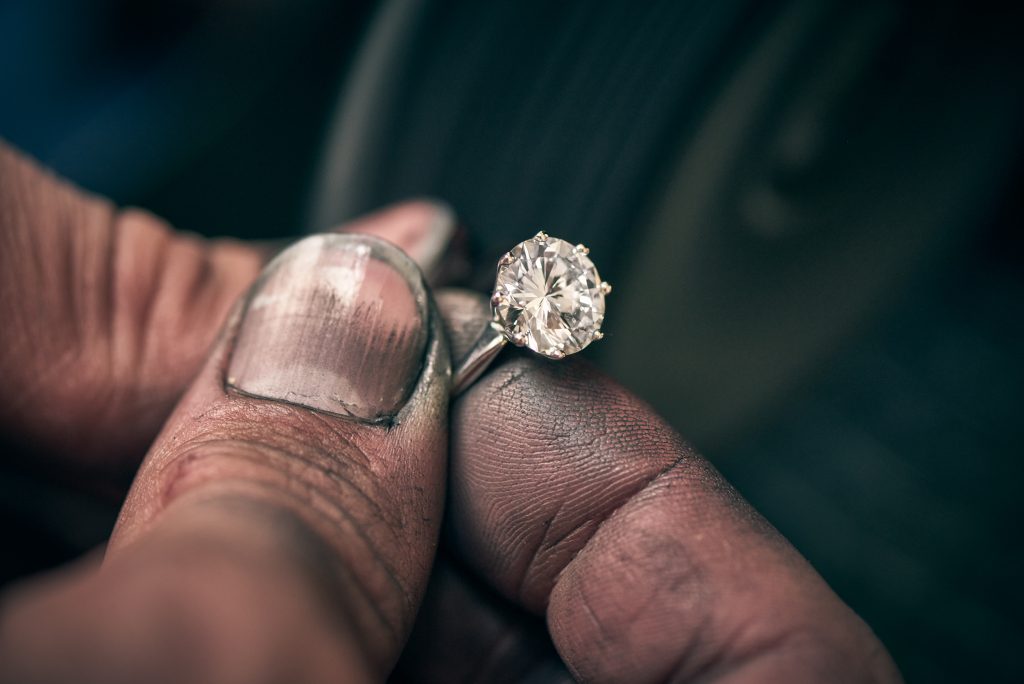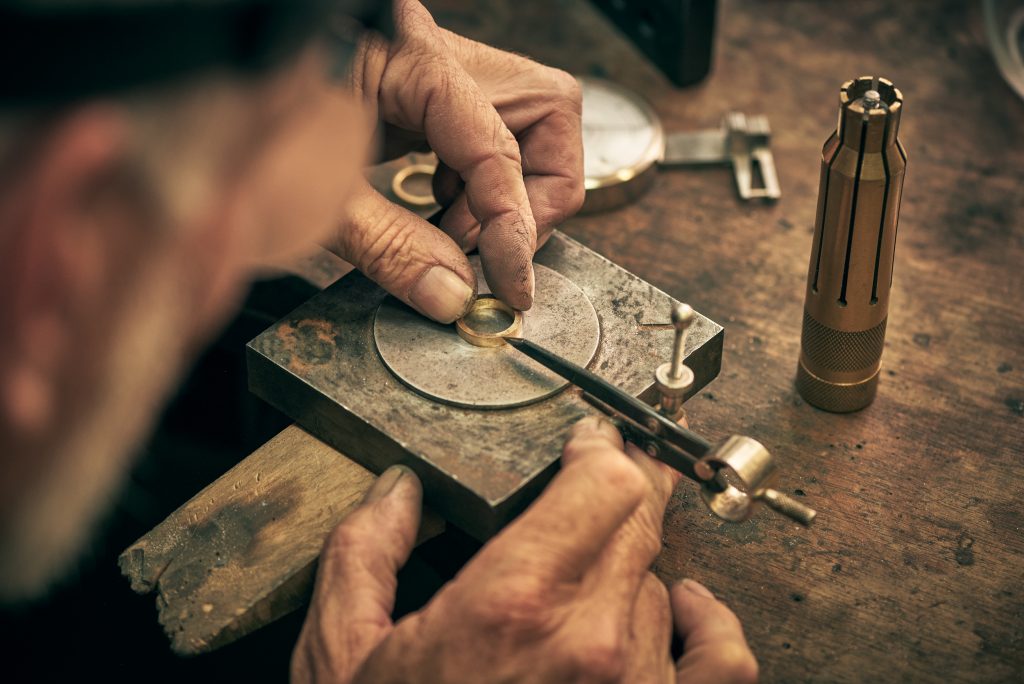Despite current economic volatility and the unknowns of life after the pandemic, the projections around industry growth are healthy, which in no small part is due to retailers and jewellers understanding the needs and desires of their customers and adapting to suit.

1/2 Bell & Brunt
Multiple factors are affecting this shift: the increased costs on real estate, lock downs and daily reliance on virtual solutions, supply chain pressures, and more. It means the make-up of retail in the jewellery industry is changing. Significantly.
Nationally, a strong number of traditional jewellers remains – that is, those who have a retail shopfront with ready made stock and some who also have hand made jewellery created onsite. But there is also an equally strong segment of the industry that is forging a new path with unique and different business models.
Kim Ridley from Q Report identifies the change in the retail environment within the industry as being due to the increased focus on the customer experience.
“The days of standing at a counter to design are moving, as the consumer wants to feel valued with an experience.”
In recent years, the Australian jewellery industry has seen an increased demand on bespoke manufactured jewellery, with bench jewellers around the country reporting high demand for custom makes, and it seems new jewellery businesses are capitalising on this shift in consumer preferences.
A recent survey conducted by the Jewellery Industry Network showed 64 percent of surveyed respondents specialised in hand made jewellery, with an additional 24 percent basing their business on a mix of ready made and hand made jewellery. A surprisingly small percentage of surveyed jewellers sell ready made products only, further confirming the shift in growth towards bespoke and handmade pieces.
Potentially due to the pandemic, but also as a response to consumer demand for experiential shopping, a significant 75 percent of respondents reported to sell from a studio, small retail shop front, or an alternative location to a shopping centre.
“The change is businesses moving to a by-appointment-only model, for those offering bespoke and manufactured pieces,” continues Ridley.
Part of the bespoke jewellery buying experience now includes the mystique of the back-stage design space, or the private boutique made available to discerning customers, she explains. The jeweller’s bench has become a destination for these types of customers, not merely an unseen workspace.
The numbers show that a growing number of jewellery businesses are operating from studio locations, or from office space with small showrooms as opposed to the traditional retail store model. It’s a trend that is allowing jewellers to not simply create beautiful jewellery for their clients, but to provide a unique experience for them too.
The Perfect Diamond is a diamond jeweller atelier in Sydney that works by appointment only. The company’s Shelley Bedarov says time is an important ingredient in the relationship between jeweller and discerning client these days.
“Luxury and custom purchases require an element of face-to-face time,” she says. “In the future, this experience will no doubt have technological aids,” but for now, customers value the personal approach.
Growing businesses are utilising a mixture of marketing communications and rely on the feedback their customers provide to further fine tune the promotion of their brands. Understanding what their consumers want affords new jewellery businesses the confidence to embrace this new business model – providing a special, tailored experience for their customer, and also ensuring they keep that experience relevant to their niche.
“Savvy jewellery retailers and premium brands are not only maintaining relevance, they are experiencing growth. Many have reported experiencing their most profitable years to date,” says Karen Denaro from the Jewellers Association of Australia.
Where are all the jewellers?
Recent Ibis reports show a predicted 3.1 percent growth in the jewellery industry between 2022 and 2027, both in terms of the number of businesses and annual revenue which they see as set to increase by 3.0 percent. But these reports seem to be missing large sectors of the industry, with the majority of the businesses in Ibis’ analysis being major chain stores and fashion jewellery retail. This may mean that the industry is, in fact, much larger than officially reported.
One statistic reported by Ibis is industry profitability, which seems to have fallen in the past five years. This may be due to increased costs in operating such as leasing and staff. These figures could be the factors underpinning the growing number of businesses that are moving to smaller locations and increasing their online presence to counteract these costs and increase their profitability.
On the other hand, many companies in the industry are reporting rapid growth, with studio start-ups increasing their staff and production in order to satisfy demand for their product and brand.
“We are constantly overwhelmed by the number of our members and community who are asking for assistance to grow their businesses, whether that be to find additional staff or get help with strategy or marketing support,” says Laura Moore, Managing Director of JIN. “It’s extremely heartening to see so many businesses in their first five years of operation who are growing so quickly and who are ready to take the next step to propel their businesses forward.”
Unfortunately a major setback for the current growth in the jewellery industry, and a factor that may limit the predicted growth anticipated by Ibis is the lack of qualified and experienced jewellers as well as retail staff who understand the industry and product.
Jobs for Jewellers, a private Facebook page for the industry with almost 4,500 members, shows a constant flow of requests to fill positions for qualified jewellers, head jewellers, bench jewellers, retail staff and jewellery admin roles. Mirrored on the Facebook Group Jewellers Co. with over 6,000 members, even more jewellery businesses are looking for staff. Without a steady increase in qualified staff into the industry, will we see this affect our ability to maintain growth?
Connecting with the consumer
Maintaining growth in the midst of a changing market will certainly have its challenges. Businesses that stand to thrive over the coming years are those that have a clear and focussed connection with their customers and that are prepared to work hard to meet their needs.
Based in their Adelaide studio, Bell & Brunt is one of Australia’s leading custom jewellers headed by co-owner and CEO Cheri Spargo. Cheri says it is crucial that they find out about their customers’ relationship, their style, and what elements they wish to capture in their personal piece.
“There is always a focus on what is most important to the customer, so when it comes to guiding them with their selection of gemstone and style, we can concentrate on what’s most significant to them,” she says. “If we can create something individual and unique just for them, we have asked the right questions.”
Cheri is confident that their particular business-model can withstand the trials ahead. Weathering Covid and rolling lockdowns and general industry downturns confers a certain strength and optimism.
“The jewellery industry has always been an essential one with people forever falling in love, getting engaged, married and wanting to celebrate their relationship milestones,” she says. “Jewellery is ever-increasing in value, and has always experienced fluctuations with price.”
From the perspective of a retailer jeweller with a long established physical presence, Mark Boldiston is more cautious.
Mark is owner and founder of Melbourne-based exclusive men’s handmade jeweller Lord Coconut, and he says sales in men’s jewellery are down.
“It’s really due to men no longer needing to wear a suit and tie to work (or even go into work) which means our second biggest range, cufflinks and tie bars, have virtually vanished after COVID.”
But Mark says taking the time to connect with every customer individually is the key to surviving in the current retail scene.
“We chat with every customer who comes into Lord Coconut,” says Mark. “We have a laugh, exchange stories and ensure they are comfortable in making a purchase. It’s all about the one-on-one relationship, not the sale itself.”
Kim from Q Report agrees that the atmosphere in store is crucial.
“The right fitout makes the whole experience more luxurious and personal. Many of us enjoy going into a luxury brand to shop as the feeling that’s created in the space makes you want to be there and buy. It feels so welcoming.”

2/2 Bell & Brunt
Flexible selling tools are essential
Economic uncertainty and the increased cost of living means many customers just can’t pay for luxury purchases such as jewellery outright. Using the latest swag of flexible payment options has become vital for traditional jewellery stores and boutique jewellers alike.
Mark concedes that while Afterpay eats into Lord Coconut’s profit margins, it’s become an important sales tool. He admits to being canny with it, though.
“(since) it’s only offered via our online store we feel it generates extra sales rather than cannibalising any existing sale.”
Karen Denaro offers every payment option available in her own business.
“I would strongly advise all jewellery retailers to explore as many options that are viable to both them and their customers, including all cashless payment plans and applications. Whatever it takes to get the sale over the line.”
Many of the mega-brands are offering cryptocurrency as a payment option these days and the technology exists to make that simple and accessible for businesses of all scales. Crypto comes with its own set of risks – and perhaps it’s only the luxury brands with a lot of fat built into their prices (and full-time financial analysts!) that can prevail through the currency’s frequent volatility.
On the backs of giants
In line with using a service like Afterpay is the ability to leverage its greater marketing reach. Small retailers and boutique jewellers may not have the budget for massive marketing campaigns, but again, our connected world affords many opportunities to hitch a ride with those who do.
Businesses who keep an eye on what their particular customer is interested in and who have the flexibility to move quickly on social media can take advantage of all kinds of broader community events and marketing opportunities.
Mark said that Lord Coconut continues to run jewellery exhibitions as part of larger city- or state-wide festivals and events such as Midsumma, Melbourne Fringe and the Seniors Festival. They also participate in sales events such as Vogue Fashion Night In, the various Afterpay events, and Black Friday/Cyber Monday.
“All of that allows us to piggyback onto the larger events which have far larger marketing budgets than we will ever have.”
Good old-fashioned VIP nights remain an essential part of doing business, whether for traditional retailers or new start-ups. With a bit of imagination, these events can be just as enticing, and successful, online.
Bell & Brunt is currently in the midst of creating exclusive VIP event evenings, and Cheri said these will only be available to the very few.
“(It) will include rare viewings of our high jewellery, designing of loose gemstones coupled with jeweller education and of course champagne, nibbles and gifts.”
The death of the retail industry has been predicted numerous times in the past – from the invention of the first department stores, to the outrage of sales via the internet, to the outbreak of the pandemic. Perhaps there’s a certain magic to our product, perhaps humans are a stubborn lot, and perhaps we’ll always need to buy something beautiful for someone we love, but whatever the reason, though times will change and clever people will change with them, the jewellery industry is still thriving.
Statistics
75 percent of respondents operate from a studio, small retail shop front, or an alternative location to a shopping centre.
3.1 percent forecasted growth in the jewellery businesses between 2022 – 2027 – Ibis
3.0 percent forecasted growth in jewellery annual revenue between 2022 – 2027 – Ibis
Read below for related stories: